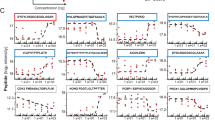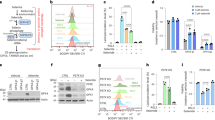Abstract
Thioredoxin 1 (Trx) is a known redox regulator that is implicated in the redox control of cell growth and apoptosis inhibition. Here we show that Trx is essential for maintaining the content of S-nitrosylated molecules in endothelial cells. Trx itself is S-nitrosylated at cysteine 69 under basal conditions, and this S-nitrosylation is required for scavenging reactive oxygen species and for preserving the redox regulatory activity of Trx. S-nitrosylation of Trx also contributes to the anti-apoptotic function of Trx. Thus, Trx can exert its complete redox regulatory and anti-apoptotic functions in endothelial cells only when cysteine 69 is S-nitrosylated.
This is a preview of subscription content, access via your institution
Access options
Subscribe to this journal
Receive 12 print issues and online access
$209.00 per year
only $17.42 per issue
Buy this article
- Purchase on Springer Link
- Instant access to full article PDF
Prices may be subject to local taxes which are calculated during checkout





Similar content being viewed by others
References
Holmgren, A. Thioredoxin and glutaredoxin systems. J. Biol. Chem. 264, 13963–13966 (1989).
Nordberg, J. & Arner, E. S. Reactive oxygen species, antioxidants, and the mammalian thioredoxin system. Free Radic. Biol. Med. 31, 1287–1312 (2001).
Matsui, M. et al. Early embryonic lethality caused by targeted disruption of the mouse thioredoxin gene. Dev. Biol. 178, 179–185 (1996).
Reichard, P. From RNA to DNA, why so many ribonucleotide reductases? Science 260, 1773–1777 (1993).
Lundstrom, J. & Holmgren, A. Protein disulfide-isomerase is a substrate for thioredoxin reductase and has thioredoxin-like activity. J. Biol. Chem. 265, 9114–9120 (1990).
Tanaka, T. et al. Redox regulation by thioredoxin superfamily: protection against oxidative stress and aging. Free Radic. Res. 33, 851–855 (2001).
Hirota, K. et al. AP-1 transcriptional activity is regulated by a direct association between thioredoxin and Ref-1. Proc. Natl Acad. Sci. USA 94, 3633–3638 (1997).
Matthews, J. R., Wakasugi, N., Virelizier, J. L., Yodoi, J. & Hay, R. T. Thioredoxin regulates the DNA binding activity of NF-κB by reduction of a disulphide bond involving cysteine 62. Nucleic Acids Res. 20, 3821–3830 (1992).
Schenk, H., Klein, M., Erdbrugger, W., Droge, W. & Schulze-Osthoff, K. Distinct effects of thioredoxin and antioxidants on the activation of transcription factors NF-κB and AP-1. Proc. Natl Acad. Sci. USA 91, 1672–1676 (1994).
Saitoh, M. et al. Mammalian thioredoxin is a direct inhibitor of apoptosis signal-regulating kinase (ASK) 1. EMBO J. 17, 2596–2606 (1998).
Moncada, S. & Higgs, A. The l-arginine-nitric oxide pathway. N. Engl. J. Med. 329, 2002–2012 (1993).
Harrison, D. G. Endothelial dysfunction in atherosclerosis. Basic Res. Cardiol. 1, 87–102 (1994).
Tsao, P. S. & Cooke, J. P. Endothelial alterations in hypercholesterolemia: more than simply vasodilator dysfunction. J. Cardiovasc. Pharmacol. 32 (Suppl. 3), S48–S53 (1998).
Murohara, T. et al. Role of endothelial nitric oxide synthase in endothelial cell migration. Arterioscler. Thromb. Vasc. Biol. 19, 1156–1161 (1999).
Dimmeler, S. & Zeiher, A. M. Nitric oxide — an endothelial cell survival factor. Cell Death Differ. 6, 964–968 (1999).
Stamler, J. S. et al. S-nitrosylation of proteins with nitric oxide: synthesis and characterization of biologically active compounds. Proc. Natl Acad. Sci. USA 89, 444–448 (1992).
Liu, L. & Stamler, J. S. NO: an inhibitor of cell death. Cell Death Differ. 6, 937–942 (1999).
Melino, G. et al. S-nitrosylation regulates apoptosis. Nature 388, 432–433 (1997).
Eu, J. P., Liu, L., Zeng, M. & Stamler, J. S. An apoptotic model for nitrosative stress. Biochemistry 39, 1040–1047 (2000).
Hoffmann, J., Haendeler, J., Zeiher, A. M. & Dimmeler, S. TNF-α and oxLDL induce a denitrosylation of proteins in endothelial cells. J. Biol. Chem. 276, 41383–41387 (2001).
Stamler, J. S., Lamas, S. & Fang, F. C. Nitrosylation. the prototypic redox-based signaling mechanism. Cell 106, 675–683 (2001).
Mannick, J. B. et al. Fas-induced caspase denitrosylation. Science 284, 651–654 (1999).
Stamler, J. S., Toone, E. J., Lipton, S. A. & Sucher, N. J. SNO signals: translocation, regulation, and a consensus motif. Neuron 18, 691–696 (1997).
Stamler, J. S. & Hausladen, A. Oxidative modifications in nitrosative stress. Nature Struct. Biol. 5, 247–249 (1998).
Jaffrey, S. R., Erdjument-Bromage, H., Ferris, C. D., Tempst, P. & Snyder, S. H. Protein S-nitrosylation: a physiological signal for neuronal nitric oxide. Nature Cell Biol. 3, 193–197 (2001).
Dalton, T. P., Shertzer, H. G. & Puga, A. Regulation of gene expression by reactive oxygen. Annu. Rev. Pharmacol. Toxicol. 39, 67–101 (1999).
Nakamura, H., Nakamura, K. & Yodoi, J. Redox regulation of cellular activation. Annu. Rev. Immunol. 15, 351–369 (1997).
Andoh, T., Chock, P. B. & Chiueh, C. C. The roles of thioredoxin in protection against oxidative stress-induced apoptosis in SH-SY5Y cells. J. Biol. Chem. 277, 9655–9660 (2002).
Baker, A., Payne, C. M., Briehl, M. M. & Powis, G. Thioredoxin, a gene found overexpressed in human cancer, inhibits apoptosis in vitro and in vivo. Cancer Res. 57, 5162–5167 (1997).
Abello, P. A., Fidler, S. A. & Buchman, T. G. Thiol reducing agents modulate induced apoptosis in porcine endothelial cells. Shock 2, 79–83 (1994).
Dimmeler, S. & Zeiher, A. M. Reactive oxygen species and vascular cell apoptosis in response to angiotensin II and pro-atherosclerotic factors. Regul. Pept. 90, 19–25 (2000).
Chandra, J., Samali, A. & Orrenius, S. Triggering and modulation of apoptosis by oxidative stress. Free Radic. Biol. Med. 29, 323–333 (2000).
Bayraktutan, U., Blayney, L. & Shah, A. M. Molecular characterization and localization of the NAD(P)H oxidase components gp91-phox and p22-phox in endothelial cells. Arterioscler. Thromb. Vasc. Biol. 20, 1903–1911 (2000).
Li, J., Billiar, T. R., Talanian, R. V. & Kim, Y. M. Nitric oxide reversibly inhibits seven members of the caspase family via S-nitrosylation. Biochem. Biophys. Res. Commun. 240, 419–424 (1997).
Dimmeler, S., Haendeler, J., Nehls, M. & Zeiher, A. M. Suppression of apoptosis by nitric oxide via inhibition of ICE-like and CPP32-like proteases. J. Exp. Med. 185, 601–608 (1997).
Haendeler, J., Weiland, U., Zeiher, A. M. & Dimmeler, S. Effects of redox-related congeners on apoptosis and caspase-3 activity. Nitric Oxide 1, 282–293 (1997).
Tenneti, L., D'Emilia, D. M. & Lipton, S. A. Suppression of neuronal apoptosis by S-nitrosylation of caspases. Neurosci. Lett. 236, 139–142 (1997)
Eu, J. P., Sun, J., Xu, L., Stamler, J. S. & Meissner, G. The skeletal muscle calcium release channel: coupled O2 sensor and NO signaling functions. Cell 102, 499–509 (2000).
Pawloski, J. R., Hess, D. T. & Stamler, J. S. Export by red blood cells of nitric oxide bioactivity. Nature 409, 622–626 (2001).
Sun, J., Xin, C., Eu, J. P., Stamler, J. S. & Meissner, G. Cysteine-3635 is responsible for skeletal muscle ryanodine receptor modulation by NO. Proc. Natl Acad. Sci. USA 98, 11158–11162 (2001).
Haendeler, J., Ishida, M., Hunyady, L. & Berk, B. C. The third cytoplasmic loop of the angiotensin II type 1 receptor exerts differential effects on extracellular signal-regulated kinase (ERK1/ERK2) and apoptosis via Ras- and Rap1-dependent pathways. Circ. Res. 86, 729–736 (2000).
Dimmeler, S., Haendeler, J., Galle, J. & Zeiher, A. M. Oxidized low density lipoprotein induces apoptosis of human endothelial cells by activation of CPP32-like proteases: a mechanistic clue to the response to injury hypothesis. Circulation 95, 1760–1763 (1997).
Park, H. S., Huh, S. H., Kim, M. S., Lee, S. H. & Choi, E. J. Nitric oxide negatively regulates c-Jun N-terminal kinase/stress-activated protein kinase by means of S-nitrosylation. Proc. Natl Acad. Sci. USA 97, 14022–14024 (2000).
Acknowledgements
We thank C. Goy for technical assistance. This work was supported by a grant to S.D. from the Deutsche Forschungsgesellschaft, Sonderforschungsbereich. J. Haendeler was supported by a grant from the Deutsche Forschungsgesellschaft. J. Hoffmann was supported by a stipendium from Boehringer Ingelheim Fonds.
Author information
Authors and Affiliations
Corresponding author
Ethics declarations
Competing interests
The authors declare no competing financial interests.
Rights and permissions
About this article
Cite this article
Haendeler, J., Hoffmann, J., Tischler, V. et al. Redox regulatory and anti-apoptotic functions of thioredoxin depend on S-nitrosylation at cysteine 69. Nat Cell Biol 4, 743–749 (2002). https://doi.org/10.1038/ncb851
Received:
Revised:
Accepted:
Published:
Issue Date:
DOI: https://doi.org/10.1038/ncb851
This article is cited by
-
Plasma protein(s)–based conceptual diagnostic tool for assessing high-altitude acclimation in humans
Functional & Integrative Genomics (2020)
-
Potential widespread denitrosylation of brain proteins following prolonged restraint: proposed links between stress and central nervous system disease
Metabolic Brain Disease (2019)
-
Role of Thioredoxin in Age-Related Hypertension
Current Hypertension Reports (2018)
-
The aryl hydrocarbon receptor promotes aging phenotypes across species
Scientific Reports (2016)
-
Profiling of cell stress protein expression in cardiac tissue of cardiosurgical patients undergoing remote ischemic preconditioning: implications for thioredoxin in cardioprotection
Journal of Translational Medicine (2015)



